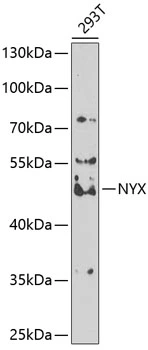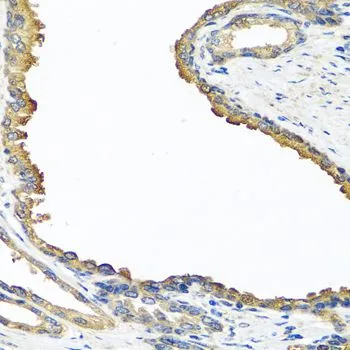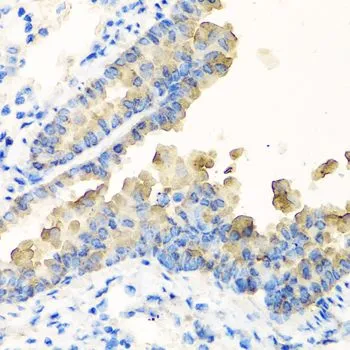
WB analysis of 293T cell lysate using GTX32763 NYX antibody. The signal was developed with ECL plus-Enhanced. Dilution : 1:1000 Loading : 25microg per lane
NYX antibody
GTX32763
ApplicationsWestern Blot, ImmunoHistoChemistry, ImmunoHistoChemistry Paraffin
Product group Antibodies
ReactivityHuman, Mouse
TargetNYX
Overview
- SupplierGeneTex
- Product NameNYX antibody
- Delivery Days Customer9
- Application Supplier NoteWB: 1:500 - 1:2000. IHC-P: 1:50 - 1:100. *Optimal dilutions/concentrations should be determined by the researcher.Not tested in other applications.
- ApplicationsWestern Blot, ImmunoHistoChemistry, ImmunoHistoChemistry Paraffin
- CertificationResearch Use Only
- ClonalityPolyclonal
- ConjugateUnconjugated
- Gene ID60506
- Target nameNYX
- Target descriptionnyctalopin
- Target synonymsCLRP; CSNB1; CSNB1A; CSNB4; leucine-rich repeat protein; NBM1; nyctalopin
- HostRabbit
- IsotypeIgG
- Protein IDQ9GZU5
- Protein NameNyctalopin
- Scientific DescriptionThe product of this gene belongs to the small leucine-rich proteoglycan (SLRP) family of proteins. Defects in this gene are the cause of congenital stationary night blindness type 1 (CSNB1), also called X-linked congenital stationary night blindness (XLCSNB). CSNB1 is a rare inherited retinal disorder characterized by impaired scotopic vision, myopia, hyperopia, nystagmus and reduced visual acuity. The role of other SLRP proteins suggests that mutations in this gene disrupt developing retinal interconnections involving the ON-bipolar cells, leading to the visual losses seen in patients with complete CSNB. [provided by RefSeq, Oct 2008]
- ReactivityHuman, Mouse
- Storage Instruction-20°C or -80°C,2°C to 8°C
- UNSPSC12352203


